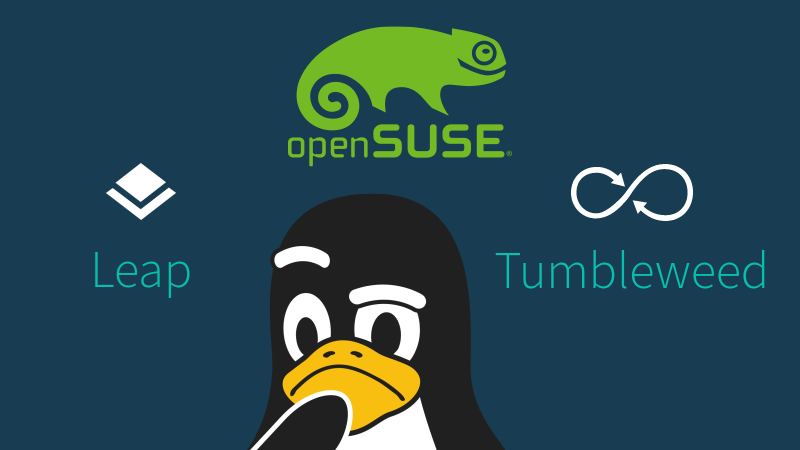When I started using openSUSE, back to 2012, “openSUSE” was the name of both the Linux distribution and the project maintaining it. Today, the openSUSE Project offers two distributions, called Leap and Tumbleweed. In this text, you are going to see how they differ from each other and how they were born.
First, let’s see what these Linux distributions are and the differences between them:
-
openSUSE Leap: more stable, keeps the regular release cycle of the old but gold openSUSE (and other traditional distributions such as Ubuntu, Debian and Fedora), but brings a new development process, it is currently at version 15.2 and new versions are released usually once a year; and
-
openSUSE Tumbleweed: is a rolling release version of openSUSE, that means it does not have different versions, but just the latest version, which always contains the latest software, Tumbleweed receives small and frequent updates whenever a software is updated, similar to distributions such as Arch, Manjaro and Gentoo.
Leap is best suited for novice users and organizations, who tend to avoid frequent updates. Tumbleweed is preferred by enthusiastic users who want bleeding edge Linux.
Usually I write about openSUSE Leap here. It’s the distro that I’ve been using for years and recommend for everyone, so much so that I made Linux Kamarada based on it. Linux Kamarada is currently at version 15.2, based on the latest openSUSE Leap release, also 15.2. I use identical version numbers to show this alignment.
A little history and more details
The openSUSE Project develops its distributions on the openSUSE Build Service (OBS), more precisely on the Factory repository. New versions of packages always enter openSUSE via this repository. If you are familiar to Debian, the openSUSE Factory repo is like the unstable (“sid”) Debian repo.
The Tumbleweed project was started in November 2010 by Greg Kroah-Hartman, a major Linux kernel developer who at that time was working for Novell, then owner of SUSE. Originally, it was not exactly an entire distribution itself, but an “add-on” set of rolling updates which could be installed on top of the regular openSUSE release.
At that time, the openSUSE Project had only one distribution, which was openSUSE 11.3.
Four years later, in November 2014, openSUSE 13.2 was released. It ended up being the last regular openSUSE release to be called as just “openSUSE”. At the same time, the Factory and Tumbleweed projects were merged, creating the openSUSE Tumbleweed rolling release we have today.
On the OBS, the Factory repo still exists internally. The core system packages are subjected to automated tests by the openQA tool integrated with OBS. When automated testing is completed and the repo is in a state considered stable, then the repo is synced to the mirrors and published as openSUSE Tumbleweed. Each of these updates are logged as snapshots and they usually happen two to three times a week.
At the end of 2014, therefore, the openSUSE Project was offering 2 distros: openSUSE 13.2 and openSUSE Tumbleweed.
Aiming to improve the release process, SUSE decided to release SUSE Linux Enterprise (SLE) sources for the community to use and help offering a distribution based on it. To express this change, the openSUSE Project decided that the version number of the next regular release would jump to 42 and the name of the distro would change to Leap. And so the successor to openSUSE 13.2 was openSUSE Leap 42.1, released in November 2015.
So, at the end of 2015, the openSUSE Project was already offering its 2 distros with the same names they use nowadays: openSUSE Leap 42.1 and openSUSE Tumbleweed.
The number 42 — the answer to “the ultimate question of life, the universe, and everything” — was a reference to the Hitchhiker’s Guide to the Galaxy. The number 1 indicated the alignment with the SLE 12 Service Pack 1 (SP1).
Probably that jump of the version number was mainly a marketing strategy, because after versions 42.2 and 42.3, the lower version numbers returned, closer to the ones used before. SUSE and openSUSE decided that the next releases of their distros would be openSUSE Leap 15.0 and SLE 15. Since then, we had openSUSE Leap 15.1 and 15.2 and the next release will be 15.3.
)](/files/2020/12/opensuse-releases.png)
openSUSE releases (source: Wikipedia)
The name Leap refers to the way how the distribution moves forward, which distinguishes it from the other distribution, Tumbleweed. By the way, have you ever seen a rolling plant in a western movie? In case you haven’t, this is what is looks like, it’s called a tumbleweed:
While Leap users “jump” from one version to another (e.g. from 15.0 to 15.1, from 15.1 to 15.2, and so on), Tumbleweed users are constantly “rolling” in the only version that exists, which is always the latest one, with the latest software.






